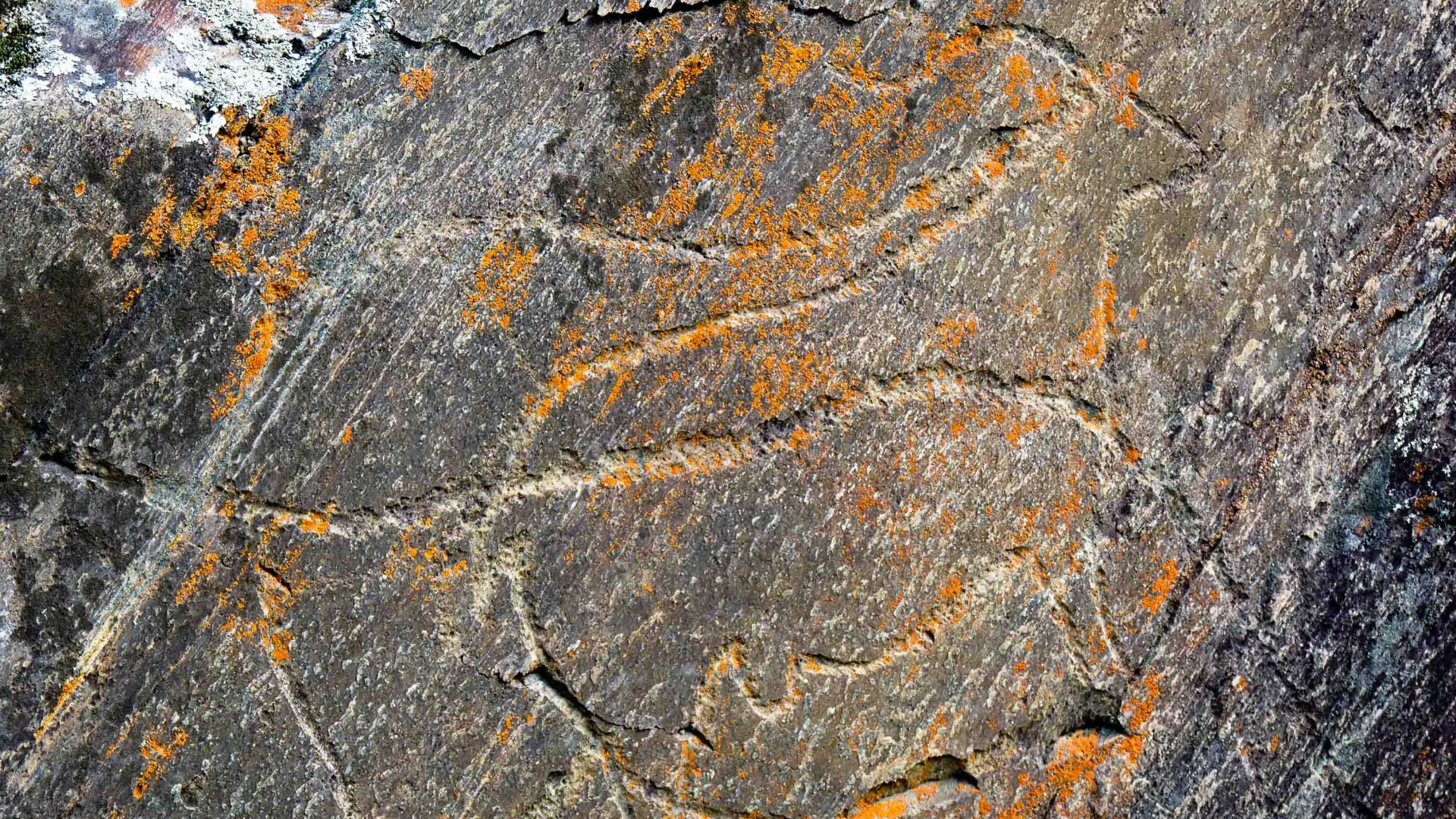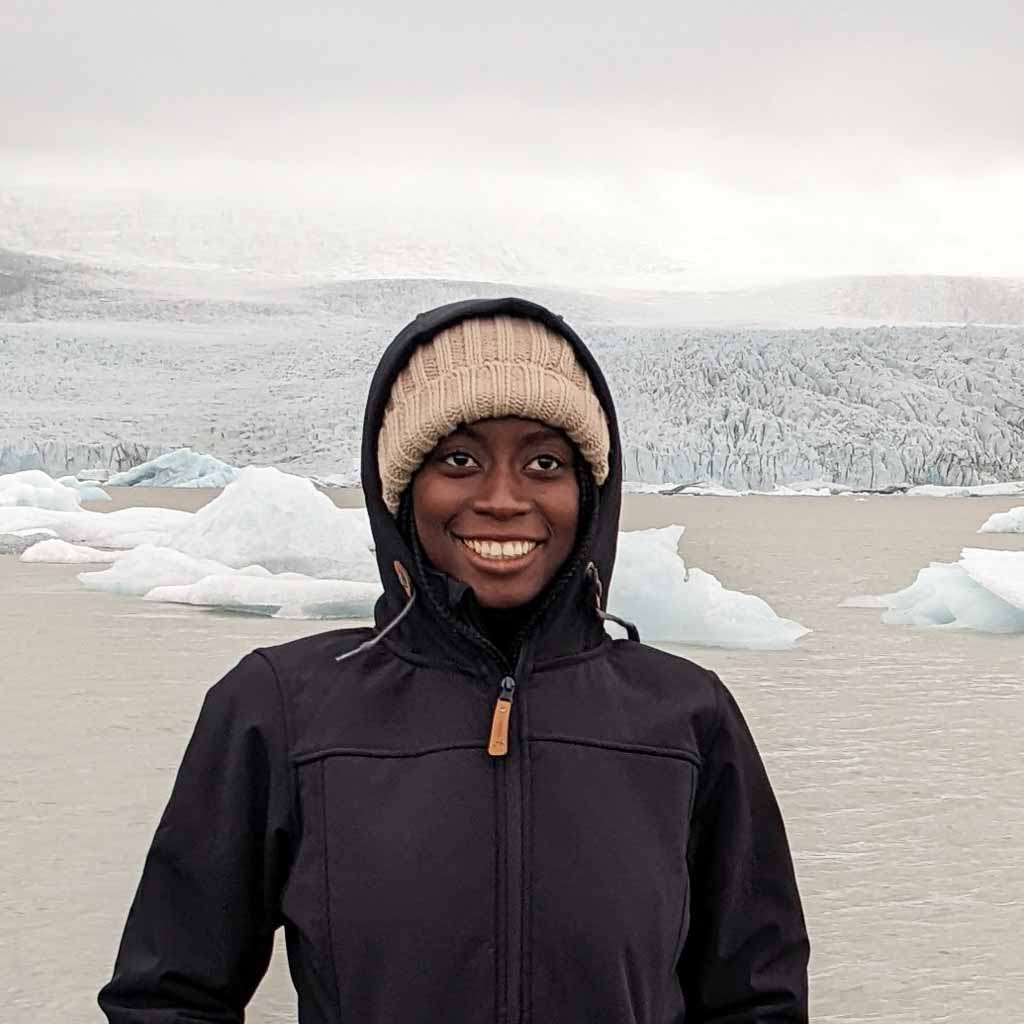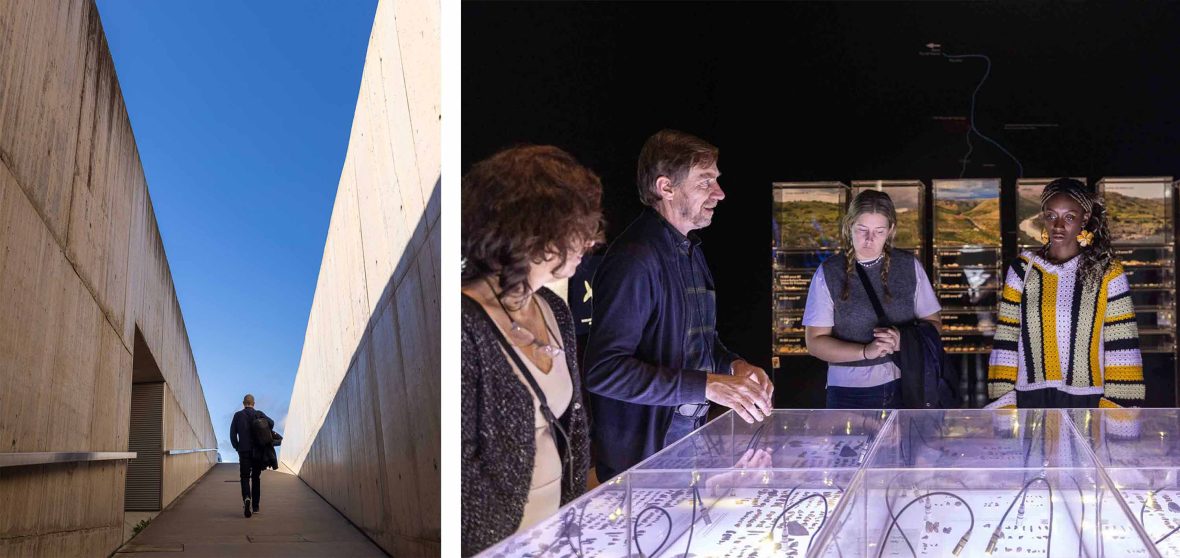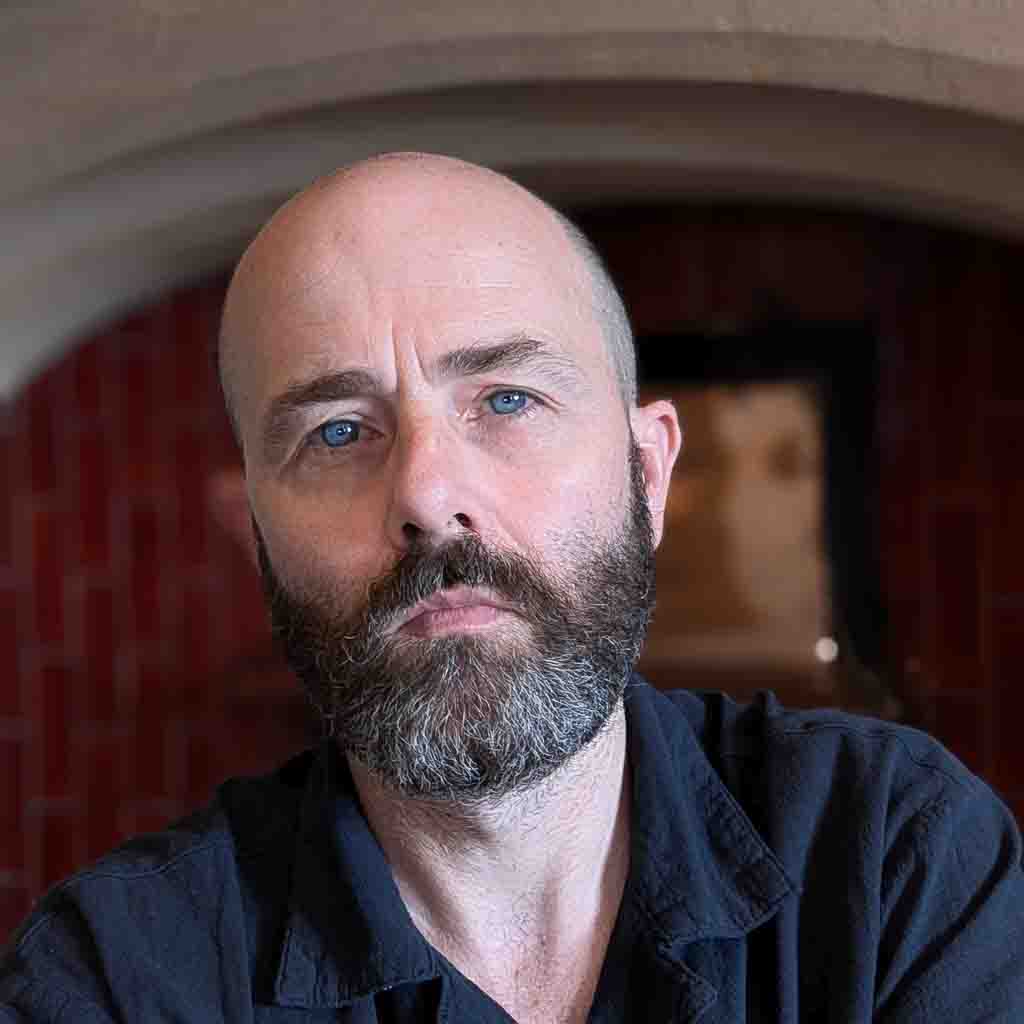
In Portugal’s Côa Valley, 16 prehistoric rock art sites tell the stories of bygone travelers—and you can only visit by night with an official guide. Liseli Thomas checks out the petroglyphs of our past.


In Portugal’s Côa Valley, 16 prehistoric rock art sites tell the stories of bygone travelers—and you can only visit by night with an official guide. Liseli Thomas checks out the petroglyphs of our past.
*Liseli Thomas was one of four mentees who participated in Intrepid’s second Diversifying Travel Media press trip in October 2024 alongside three fellow mentees/aspiring travel journalists and four mentors/established travel writers and editors.*
“We’re here.”
I peer out the van window, but there’s only more of the endless darkness that has surrounded us on the bumpy descent into Côa Valley’s mountain ranges.
Neighbor to northern Portugal’s famed Douro Wine Region, Côa Valley is a landscape steeped in history, and its history is etched, quite literally, into the land. As we climb out of the car, I realize I’m excited to get a first-hand viewing of ancient art left behind by the region’s nomadic Neanderthals, who traversed Spain and Portugal in the Iberian Peninsula.
It is perfectly still, as things so rarely are, with only the nearby River Côa’s streaming water to intercept the quiet darkness. I want to ask our guide Ana Berliner exactly where we are, but when she cuts the engine and her front lights shut off, the sight above silences my unsaid question.
Hundreds of stars illuminate the night sky above, each shining so brightly that I can spot Orion without squinting. An awed chorus erupts around me “Beautiful, isn’t it?” Ana muses as she looks up. “Keep your eyes up. You might spot a shooting star.”
The words barely leave her lips before a streak of white burning light dashes across the sky. “I saw one!” I exclaim, shocked. I’m already enthralled with our destination—and I haven’t even seen the art yet.
We’re at the Penascosa Site, one of three main visitable Paleolithic art sites in the Côa Valley, and best viewed at night with a local, licensed guide booked through the Côa Valley Archaeological Park or local stays. Ours, Ana, is also our host, and we’re staying at her guesthouse in Castelo Rodrigo while we explore this unique region by the Spanish border.
So far, Ana has introduced us to local dishes such as feijoada, a bean and meat stew, and guided us on hikes through the Entrada Sul trail of the Faia Brava natural reserves. But tonight, we follow her along the unmarked paths that the Neanderthals might have once traversed.
The sites were first discovered in the early ‘90s by an archaeological team performing an impact report for the construction of a 328-foot-high (100 meters) dam. The project was already in motion, but the discovery sparked massive protests throughout the country to stop development before it submerged the open-air petroglyphs; both the uncovered ones, and those possibly waiting to be found.
Silhouettes reveal themselves, ones with horns, tails and strong, thick frames. “This is why we come at night,” Ana explains. “In the day, you can not manipulate the light, but at night, it is easier.”
Four years passed before the project was abandoned, losing more than GBP£200 million (USD$266m) in the process, and the saved art was named a UNESCO World Heritage site in 1998.
Since then, more than 100 sites showcasing thousands of animal figures have been uncovered between Spain and Portugal, with 16 in the Côa Valley alone, estimated to date back to over 80,000 years ago, compared to other famous Stone Age art in Europe, such as the Lascaux cave paintings in France which date back to roughly 17,000 years. We follow closely behind Ana and her trusted torch, eager for our first glimpse. When she suddenly stops, we’re all surprised to discover we’re about to see something already.
Hidden within the darkness, a single slab of rock pitches from the earth, its edges jagged, while its flat surface remains an untouched canvas since its last artist.
Etched lines, thick and small, stack on top of one another, moving higher until there’s no more room left—but what the lines mean is lost to me until Ana places her torch on the ground and angles it upwards.
Silhouettes reveal themselves, ones with horns, tails and strong, thick frames. “This is why we come at night,” Ana explains. “In the day, you can not manipulate the light, but at night, it is easier.”
Only the day before, I visited the Côa Museum with Ana—it’s one of the largest Portuguese museums and its location at the mouth of the Côa River marks the meeting of two UNESCO heritage listings in this region: The Prehistoric Art of the Côa Valley and the Douro Wine Landscape. It was here where we first learned to identify the imprints of certain animals so now, standing in front of the rock by night, it’s easier to spot the depiction of a mighty Auroch. The depiction of the domestic cow’s wild ancestor is larger than the other engravings of horses and mountain goats, the lines of its horns unmistakable.
“This could be a warning to tell others what is in the area,” Ana explains while she follows the outline of the creature with her laser; her laser falls on the horse next, and its two heads.

While the depiction of movement is not common in most Paleolithic art, it is seen regularly within Côa Valley. The Neanderthals who once lived here appear to have created what might be the first examples of modern animation by etching their muses in various stages of movement.
“Why are they all layered?” one of my group asks as we walk the short distance to the next site. “There are other rocks, but they all use one slab.”
“Why do people write their name over others’ names in a bathroom stall?” Ana jests. “People want to be seen.”
“I always thought rock art was in caves or museums,” I admit to Ana within the darkness. “But it’s out here as part of the natural landscape.”
The reasoning behind why the Neanderthals left depictions of the animals around them is not something we can ever have a definite answer to—but just as we all seek to make our mark, it is not a grave presumption to assume they might have as well.
If this is the case, then they’ve certainly ensured that their stories are left open for interpretation for generations to come.
It’s been almost 30 years since the Penascosa Site was named a UNESCO World Heritage Site, and yet, the barriers or glass that usually come between us and ancient art are absent. It remains untouched but free to the public eye.
Of course, this is mostly because only locals are licensed to be tour guides, ensuring that, as tourism grows within the region, only members of the community know the winding roads that lead to the depths of the valley. Thus far, it’s working.
Of all the sites we visit, only one petroglyph, positioned at our feet, sits alone. I would’ve walked right past it if it weren’t for Ana’s knowing light. It’s a sturgeon—and the first depiction of an aquatic animal we have seen. None of us can guess why it’s there or what it means. Not until Ana reminds us of the River Côa flowing behind us, its path a direct mirror of the path we have walked to each site.
Could one of the members of this nomadic Palaeolithic society have been trying to tell another that there was food to find? Or had they glimpsed a sturgeon jumping from the water and wanted to portray it? Were they simply leaving their mark by depicting a moment or feeling, as so many unknown street artists do today?
The matter is up for debate, as many remnants of ancient civilizations are, but there is no denying how awe-inspiring it is to stand where the artists behind these etchings once stood, under the same night sky, listening to the same flow of the river at our backs.
“I always thought rock art was in caves or museums,” I admit to Ana within the darkness. “But it’s out here as part of the natural landscape.”
“This is what art is—public,” she replies. “It’s not hidden. It’s for everyone.”
That sentiment is one I find myself pondering as we walk back to Ana’s van. There’s a certain magic that appears in viewing art like this, and even though the Earth has gone through many changes since they were first engraved, who are we to disturb them? Should we not appreciate this art as it was first intended? Perhaps not for all Stone Age art, but open-air art that claims nature as one of it’s mediums, maybe so. I can’t help but think yes as I walk along these artists’ unmarked paths.
**
This trip was based on elements of Intrepid’s Portugal Real Food Adventure which visits parts of rural, northern Portugal, including the Côa Valley.
****
Adventure.com strives to be a low-emissions travel publication. We are powered by, but editorially independent of, Intrepid Travel, the world’s largest travel B Corp, who help ensure Adventure.com maintains high standards of sustainability in our work and activities. You can visit our sustainability page or read our Contributor Impact Guidelines for more information.

Liseli Thomas is a Trinidadian-Zambian travel writer with a penchant for seeking more daring exploits while traveling. Raised in Barbados, she cultivated a unique lens from the local viewpoint, which continues to ground her articles with a distinctive angle. She has produced multimedia content for National Geographic Traveller (UK) and ASTA Worldwide Destination Guide.








Can't find what you're looking for? Try using these tags: